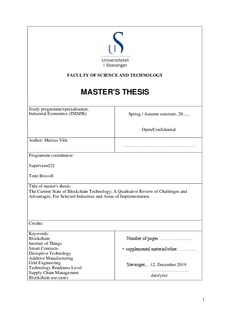| dc.description.abstract | Blockchain technology first reached popularity through cryptocurrencies such as Bitcoin in 2008 [3]. The concept attracted users with anonymity, high levels of security, no trust-tax and international peer to peer trading of currency [4]. Blockchain for purely financial purposes are referred to as Blockchain 1.0, and since the emergence of early cryptocurrencies, the technology has matured significantly. Blockchain 2.0 (Smartcontracts) and Blockchain 3.0 (Other) have opened a large amount of new applications and potential business-opportunities.
Although much research has been conducted on blockchain, papers often focuses on cryptography, data science, security and strict financial applications for blockchain 1.0 [5]. Many of which are seeking to improve the currently available blockchain technology, by focusing on technical aspects such as scaling-properties or increasing security through improved consensus algorithms. As a result, little research is available on industry-specific challenges of current blockchain 2.0 and 3.0 technology. Untraditional use-cases such as Project Management (PM) tools are also largely left underexplored [5] in current research. This may create an inflated focus on theoretical challenges regarding the current state of blockchain technology, and subsequently ignore many of the unique incentives and challenges not discussed in data science and cryptography publications.
To cover the gap in existing research on the current state of blockchain technology, the following problem statement was used:
“What is the current level of technological maturity, with subsequent challenges and advantages to implementing blockchain technology with focus on selected industries and areas of implementation, outside strict Blockchain 1.0 applications?”
This qualitative thesis uses a purposely wide scope to evaluate the main aspects of current blockchain technology, outside traditional, pure blockchain 1.0 applications. Challenges and advantages to implementation are explored through literary research and review of existing blockchain-projects, hoping to create a more well-rounded snapshot of the technology and its current maturity. The thesis explores Grid engineering, Internet of Things (IoT), Smartcontracts, Distributed manufacturing and supply chain management. Possibilities within PM is also explored, as very little available research is available on PM applications.
The thesis researches both peer reviewed and grey literature to evaluate blockchain technology. The theoretical portion of the thesis starts by exploring the general characteristics of blockchain technology, focusing on technological features and current state of technology. Based on the theoretical foundation, research is extended to include and evaluate existing projects to provide a more complete view of the current state of blockchain technology. In addition to commercial projects, the thesis investigates platforms such as IOTA, Ethereum and Hyperledger. The presence of a functioning platform greatly reduces implementation difficulty for the relevant area of application.
To gauge whether blockchain is more than just an overly marketed trend, key challenges of each selected area of interest is summarized and reviewed. Blockchain functionality is then assessed as a means of solving or improving the current most common challenges for each area of implementation, or the unique features it may ad. In most cases reviewed, blockchain offered clear improvements and/or solutions, to several key issues faced in the respective area of implementation.
To assess the maturity of current blockchain technology, the NYSERDA Technology Readiness Level (TRL) algorithm was used to assess 1 concept from each area of implementation. TRL scores ranged from low 3 to a perfect 9, showing clear differences in the level of current maturity within current blockchain concepts and use-cases. Issues such as scaling, lack of engineering skill, lack of supporting hardware, lack of standards and legislative frameworks are reoccurring across concepts. Some areas such as Grid engineering and supply chain management seem far more ready and applicable for the move to blockchain than distributed manufacturing systems and PM.
The main reoccurring challenges to current blockchain technology are not exclusively a result of immature blockchain technology. Technological faults such as the scaling-problem and selfish mining, are considered the most noticeable technological hurdles when implementing current blockchain technology. Although blockchain systems may be beneficial for PM, these positive effects are usually carry-over effects from implementing blockchain technology to the supply-chain or manufacturing process of a project, and not as a tool tailored for PM. Smartcontracts are also identified as the key functionality, necessary for full utilization of current blockchain technology. | nb_NO |
